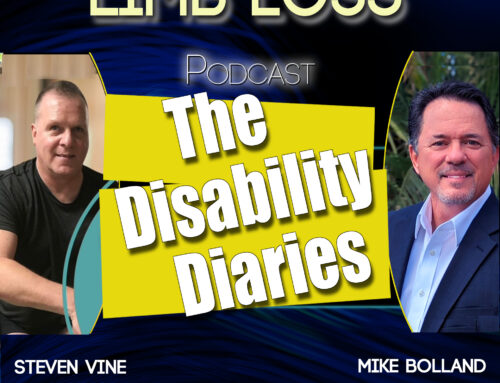Listen as host Mike Bolland picks three limb loss/amputee headlines for the week and discusses them in these ‘Headlines” episodes.
Headline #1: Michael Palin says he still talks to his late wife: ‘It’s a bit like losing a limb’
Sir Michael Palin has opened up about life without his late wife, Helen Gibbins, saying he still talks aloud to her.
The 81-year-old Monty Python star and travel documentarian announced in May 2023 that his wife of 57 years had died of kidney failure. She also suffered with chronic pain for several years.
The couple had met on a beach in Suffolk when they were teenagers, and Gibbins variously worked as a teacher, a therapist and a bereavement counsellor throughout her life.
Speaking on ITV’s Good Morning Britain on Monday (24 June), Palin said: “It’s like you’re a unit, and suddenly you are not a unit any longer, and it’s a bit like losing a bit of a limb, you’re not quite sure where you are.”
The reason I find this story interesting is because many times on the “We’re Not Stumped” podcast, my guests who have had amputations have said ‘losing a limb is like losing a family member’.
Sir Michael Palin added: “I do hear her and she had a great sense of humour. Sometimes I will have done something and I’ll get back and tell her about it. Although she’s not there, I know her reply and it makes me smile.
“I find myself idiotically in the sitting room on my own going, ‘Oh yes!’ So that’s good.
“She was great and we have good memories. So much of your own life is invested in that one person so there is a huge slice of my life which I now can’t really access in the same way.
“But we’ve got family, children, grandchildren, they sort of take over, but it’s not the same, not quite the same.
“It’s been just over a year but I get on with work, that’s the thing. And I hear Helen saying, ‘Get on with it, go on, stop messing about.’”
The couple had three children and four grandchildren, and celebrated their 57th wedding anniversary just two-and-a-half weeks before her death.
Headline #2: Blue Arbor goes beneath the surface for better control of limb prosthetics
Blue Arbor Technologies is developing implantable sensors to give patients better control of cutting-edge prosthetic arms and hands — with potential exoskeleton applications in the future.
In April 2024, the FDA gave breakthrough device designation to Blue Arbor’s RESTORE Neuromuscular Interface System and enrolled it in the agency’s Total Product Life Cycle Advisory Program (TAP) pilot to get the technology to patients faster. (RESTORE is an acronym of “Reimagining Engineering Solutions To Optimize Restoration of Extremities.”)
Research efforts started in 2007 and have since totaled $45 million, said Blue Arbor co-founder and President Dr. Paul Cederna, who trained as a biomedical engineer before becoming a surgeon specializing in complex wound reconstruction.
“I have been performing research in this space primarily to try to enhance function for people with limb loss,” Cederna said in an interview. “That was driven by the patients I take care of on a daily basis who have horrible, traumatic injuries, cancer operations where they lose their limbs, or other medical conditions that lead to limb loss. So for me, it was entirely driven by a world where people with limb loss just were not getting what they needed to rehabilitate their lives back to where they were before.”
Ann Arbor, Michigan-based Blue Arbor doesn’t make prosthetics, but rather a system with implanted electrodes to give patients more control over state-of-the-art prosthetics than they have with electrodes placed on their skin. Implanting the electrodes offers a better way to sense a limb-loss patient’s nerve activity to control a robotic hand or arm.
The patient calibrates the algorithm in about five minutes using an app that asks them to mimic finger, wrist and elbow movements with their phantom limb, training the algorithm how those movements relate to the nerve signals.
“In research [with our four patients], we’ve always started with a personalized algorithm, so they’ll calibrate and train from scratch,” Vaskov said. “As we collect more data and can evaluate more data, there’s probably the opportunity to have a general model so someone can go out immediately with a starting point and then tweak it to make it better.”
Headline #3: Prototype Smart Socket Shows Promise for Amputees’ Comfort. This is from our friends at Amplitude Magazine
A few years ago, Amplitude surveyed the latest breakthroughs in “smart sockets,” or sockets that auto-adjust in real time to fluctuations in the size and shape of the residual limb (“Smart Sockets Are on the Horizon,” November/December 2021). Such devices could reduce or eliminate the near-universal aggravations that come with socket misfits, including blisters, sores, rashes, and circulatory problems.
One of the research initiatives cited in that article, the University of Washington’s motor-driven smart socket, has reached the early testing phase—and the results are encouraging. In a new paper published last month in Nature Scientific Reports, the UW team shared the outcomes of an early trial involving an auto-adjusting socket. The prototype device offered two innovative modes of real-time socket adjustment—manual adjustment via a smartphone application, and automated adjustment driven by sensors embedded within the socket. “These advances have the potential to enhance prosthesis users’ quality of life by reducing the mental and physical burdens surrounding routine socket fit adjustments,” the authors concluded.
Smart sockets are difficult to engineer for multiple reasons, but the core conflict boils down to the need for a tight, stable interface between socket and limb that does not irritate or damage soft tissues.
The device was tested by 12 participants ranging in age from 35 to 78, with a median duration of 17 years post-amputation.
Two of the participants did not test the auto-adjust mode, and one chose not to test the locked mode. Here’s a quick summary of the results:
- Six of the 12 participants had their highest daily step counts in auto-adjust mode
- Of the nine participants who tested all three modes, all nine said they got the best fit from either auto-adjust or manual-adjust mode
- Nine of the 12 participants said they would use a smartphone-controlled manual-adjustment feature if one were commercially available
- Nine of the 12 also said they would use a device that monitored and logged socket-fit data in real time
- Ten of 12 stated if logged socket-fit data were available, they would share it with their prosthetist, physical therapist, and other clinicians.
Listen on Apple Podcasts
Watch on YouTube
Listen on Spotify
Tom Lenoble’s story is a powerful combination of leadership, resilience, and personal transformation. In this inspiring interview, Tom reflects on his remarkable career leading global customer operations for major brands like MCI, Walmart.com, Palm, and Facebook, where he helped build the company’s first customer operations organization during its explosive early growth. Beyond his Silicon Valley leadership achievements, Tom opens up about surviving two life-threatening illnesses, living with HIV, and battling metastatic cancer for 13 years while continuing to lead, inspire, and thrive. His bestselling memoir, My Life in Business Suits, Hospital Gowns, and High Heels, reveals the deeply human side of his journey — from corporate success to vulnerability, healing, and purpose.
In this deeply moving episode of We’re Not Stumped, host Mike Bolland welcomes Scott Martin, a bilateral hand amputee, soccer coach, and author of the upcoming memoir Play From Your Heart. Scott opens up about the life-altering infection in 1993 that led to the loss of both hands and parts of his feet, and the emotional aftermath that followed. He speaks honestly about denial, detachment, and the five-year struggle with depression that tested his identity, confidence, and purpose.
This special Christmas episode of We’re Not Stumped is a heartfelt reflection from host Mike Bolland on resilience, community, and gratitude during the holiday season. Instead of an interview, Mike takes a few minutes to acknowledge the realities many people in the limb loss and disability community face during the holidays — from accessibility challenges and family dynamics to grief, growth, and adapting to change — all with warmth and a touch of humor. Mike also shares what this podcast has taught him over the past year and gives a heartfelt shout-out to some incredible guests who trusted him with their stories.









Leave A Comment